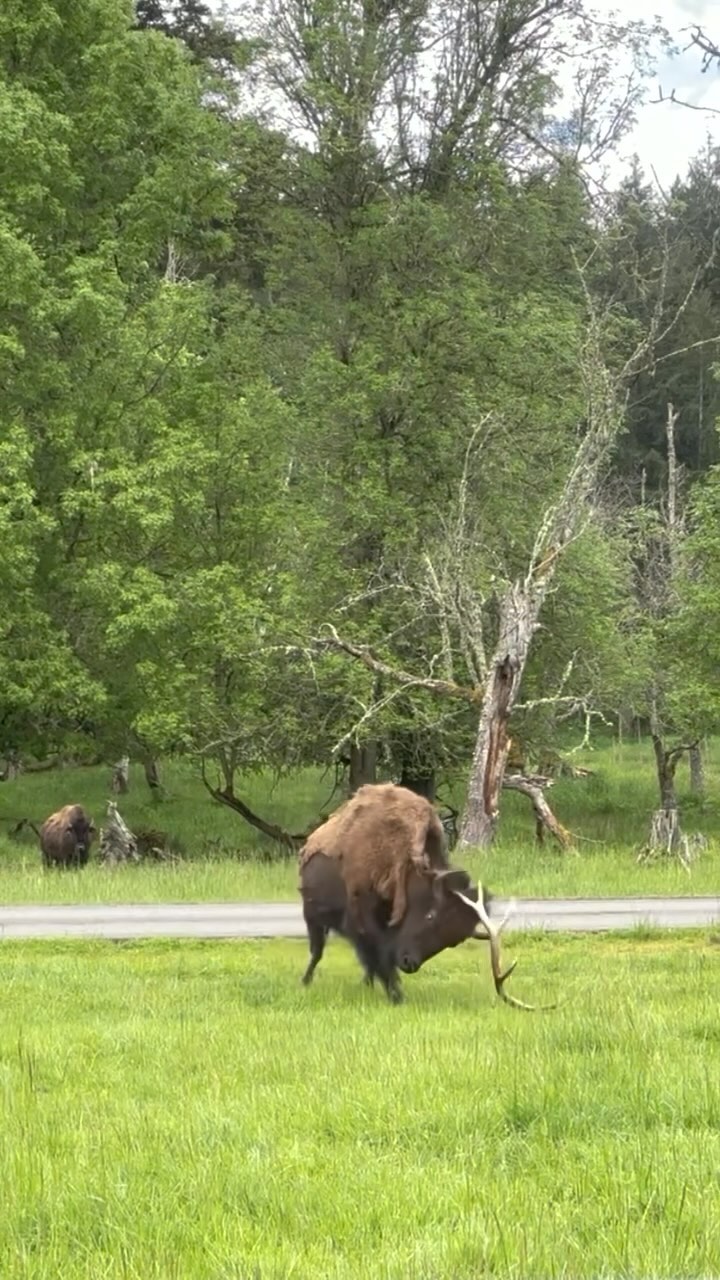- Insights into bison behavior and the significance of enrichment activities in wildlife management
- The crucial role of zookeepers in wildlife conservation efforts and education
- The ecological importance of bison in their natural habitats
- The process and benefits of antler shedding in cervids (e.g., elk)
- The role of interactive tours and social media in fostering public interest in conservation
Wildlife management and animal care have evolved significantly over the years, adopting strategies that promote the health and well-being of the animals and engage and educate the public. A heartwarming example of this is seen in the anecdote of keeper Stephanie, who, during a Keeper Adventure Tour, observed a female bison engaging with an elk antler for enrichment. This act highlights the broader practices of modern zoos and wildlife preserves in crafting environments that stimulate animals’ physical and mental activity.
Bison, the largest mammal in North America, have exhibited various fascinating behaviors that captivate the attention of both scientists and enthusiasts alike. Though often pictured grazing calmly in grasslands, these animals are also known to interact playfully with their environment. The scene of a bison with an antler may initially seem peculiar, but it aligns with the species’ known curiosity and playfulness.
Enrichment is a fundamental aspect of animal welfare in managed settings aimed at enhancing the quality of life for the animals. It focuses on providing activities that stimulate their senses and encourage natural behaviors. Items such as antlers are significant enrichment tools because they are natural objects that animals encounter and interact with in the wild. Through such engagements, animals can practice skills essential for survival, like foraging, problem-solving, and maintaining physical fitness.
In zookeeping, the keeper has to oversee these enrichment activities, ensuring they are safe and beneficial for the animals. Keeper Stephanie’s experience displays the intimate role of keepers in the daily lives of the animals they tend to. They are caretakers and observers, continually learning and adapting the care they provide based on each animal’s needs and behaviors.
Moreover, zookeepers play a pivotal role in wildlife conservation and education. Sharing these moments with the public helps bridge the gap between humans and wildlife. In the case of bison, these efforts are particularly relevant given the species’ history – once on the brink of extinction due to overhunting and habitat loss, their populations have rebounded thanks to concerted conservation initiatives. Now, bison are seen as a conservation success story, and illustrating their behaviors and management can inspire continued support for such efforts.
Beyond their charisma, bison hold significant ecological roles. As keystone species, they influence the structure and function of their environments. Their grazing habits help maintain the grassland ecosystem, fostering biodiversity. Their wallowing – rolling in the dirt – creates depressions that collect water and support a variety of wildlife. Such insights into bison ecology underscore the importance of their conservation and the preservation of their natural behavior patterns, even within the confines of managed care.
Turning to the elk antler at play, the role of antlers in cervid biology and ecology is another fascinating topic. Antlers are an example of deciduous appendages – grown, shed, and regrown annually by members of the deer family. Hormonal changes and environmental cues drive this cycle. Antler shedding serves several purposes, including freeing the animal of a cumbersome weight post-rut (breeding season) and ensuring that the animals grow a new set that’s stronger and potentially more impressive for the next season’s displays and competitions. By leaving antlers in the bison’s environment, such as the case in the Free-Roaming Area mentioned by keeper Stephanie, we mimic natural processes and provide organic enrichment opportunities.
Interactive tours like the Keeper Adventure Tour offer in-person experiences that can foster a deeper appreciation for wildlife. These tours often provide insights into the inner workings of animal management and the specifics of individual species’ care. Moreover, glimpses into these moments can be shared widely through social media, expanding their educational reach. Videos like the one shared by Stephanie can spark conversations and interest in wildlife conservation, making such platforms powerful tools in the modern conservationist’s toolkit.
For wildlife enthusiasts and the public alike, learning about enrichment practices, such as the happy bison playing with an elk antler, is enjoyable and instructional. It serves as a reminder of the richness of animal life and the ongoing need to support conservation efforts that ensure these creatures continue to thrive. IonicModule, such narratives encourage an informed and engaged public, essential in the collective effort to protect and preserve our natural world.
Conservation is not a passive venture. It requires active participation, diligent management, and public education. With the help of social media and the dedication of wildlife professionals like keeper Stephanie, more individuals can witness Another Happy Bison, be captivated by their playful interactions, and feel moved to support these magnificent animals’ ongoing protection and care.
*****
Source Description
Another happy bison! 🥰🦬 During a Keeper Adventure Tour, keeper Stephanie came across a female bison adorably playing with an elk antler. Antlers are shed every year. We leave a couple antler sheds in the Free-Roaming Area for animal enrichment. Others are collected for education.
📹: Keeper Stephanie
class=”instagram-media” data-instgrm-permalink=”https://www.instagram.com/reel/C7LDloIr55L/” data-instgrm-version=”14″ style=” background: border:0; border-radius:3px; box-shadow:0 0 1px 0 rgba(0,0,0,0.5),0 1px 10px 0 rgba(0,0,0,0.15); margin: 1px; max-width:540px; min-width:326px; padding:0; width:99.375%; width:-webkit-calc(100% – 2px); width:calc(100% – 2px);”>


